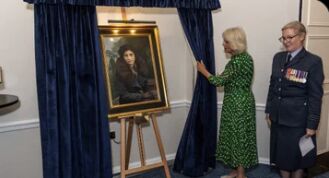Queen Camilla unveils portrait of Indian-origin spy Noor Inayat Khan, honoring her courage and resilience in World War II
Queen Camilla of Britain unveils a new portrait of Noor Inayat Khan, an Indian-origin spy, at the Royal Air Force Club in London. The portrait honors Khan's bravery and resilience during World War II.
Queen Camilla of Britain has revealed a new portrait of Noor Inayat Khan, an Indian-origin spy who was an undercover agent for Britain's Special Operations Executive (SOE) during World War II. The portrait was unveiled at the Royal Air Force (RAF) Club in London, where a room has also been officially named after Noor Inayat Khan. The room, known as the "Noor Inayat Khan Room," houses the portrait alongside a stained-glass window that celebrates women in the RAF.
The Royal Air Force Club was honoured to welcome Her Majesty The Queen on 29 August 2023 to unveil a portrait of Assistant Section Officer Noor Inayat Khan, GC, a heroine of the Special Operations Executive. pic.twitter.com/ws6UJ5FvUF
— Royal Air Force Club (@TheRAFClub) August 29, 2023
The queen was accompanied by British Indian author Shrabani Basu, who presented her biography of Noor Inayat Khan, titled 'Spy Princess: The Life of Noor Inayat Khan.' Noor Inayat Khan, born Noor-un-Nisa Inayat Khan in Moscow in 1914, was the daughter of an Indian sufi saint father and an American mother. She moved to London at a young age and later settled in Paris for her schooling. After the fall of France during World War II, she escaped to England and joined the Women's Auxiliary Air Force (WAAF). In 1942, she was recruited into the SOE. Noor Inayat Khan became the first woman SOE operator to be infiltrated into France, landing there on June 16, 1943, via a Lysander aircraft.
Despite the capture of most of the Paris Resistance Group she worked with by the Gestapo in the following weeks, she refused to return to England, determined to support her French comrades and rebuild the group. In October 1943, Noor was captured by the Gestapo, who knew her only by her code name 'Madeleine.' Despite brutal interrogation, she refused to disclose any information about her work or colleagues. She was imprisoned at Gestapo HQ, where she made two unsuccessful escape attempts before being sent to Germany for so-called 'safe custody.'
Noor was considered a dangerous and uncooperative prisoner. Noor Inayat Khan was awarded the George Cross (GC), the highest award for heroism, posthumously for her exceptional courage and bravery over a period of more than 12 months. She was shot by the Gestapo at Dachau concentration camp in Germany in 1944, with the word "liberty" on her lips. The portrait of Noor Inayat Khan was created by renowned British artist Paul Brason, who based it on the limited available images of her. The portrait aims to capture her determination and resilience as an undercover agent who never succumbed to Nazi interrogation.
The unveiling ceremony was attended by Noor's relatives, including her 95-year-old cousin Shaikh Mahmood and nephew Pir Zia Inayat Khan. The RAF Club, established in 1918, is a private members' club and registered charity that serves as a gathering place for officers of the RAF and their families. With approximately 24,000 current and former RAF officers as members, the club provides a supportive home away from home for these individuals. The unveiling of Noor Inayat Khan's portrait at the club ensures that her story will be remembered by future generations.




